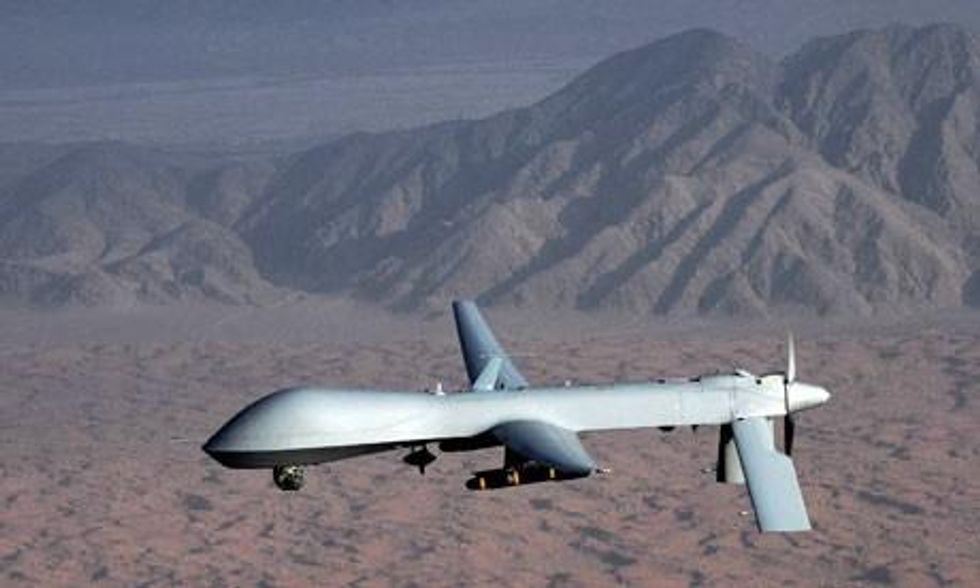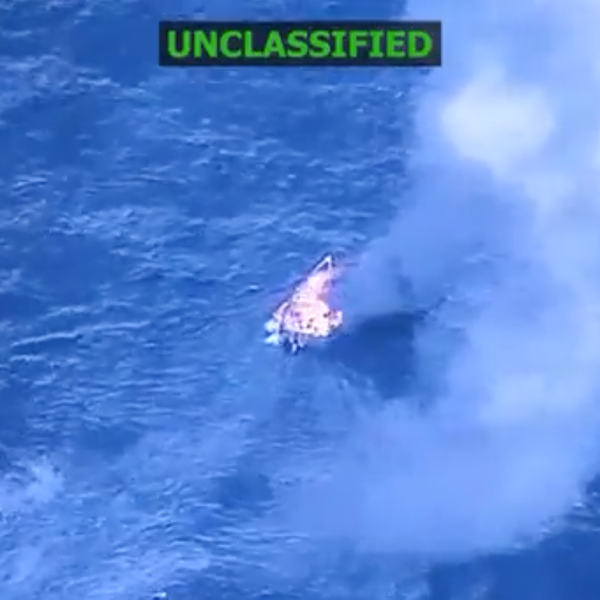Should We Allow NATO Free Rein to Attack and Kill People?
The airstrike that killed 24 Pakistani soldiers is just the latest in a series of mistakes that raise doubts about NATO's credibility

Why did NATO forces kill two dozen Pakistani soldiers at a border post in the Mohmand region, some 300 yards across the frontier from Afghanistan early on Saturday morning? The US military claims the attack was in response to hostile fire, and the Pakistanis are demanding proof of that.
There is a very simple explanation of what happened: the US military makes deadly mistakes all the time, and for all its technological wizardry and tremendous firepower, it has very little intelligence on the ground.
"There are many questions that need to be answered," an editorial in the New York Times pronounced:
"Who first fired on the American-Afghan force? Pakistan's army is far too cozy with the Taliban. Were fighters sheltering near the Pakistani outposts? What about Pakistan's claim that the NATO strikes continued for two hours even after Pakistan alerted allied officials? What needs to be done differently going forward?"
In New York and Washington, this is standard fare. We can't trust the Pakistanis, they are with the terrorists. But can we trust NATO or the US military? There are numerous examples of firing on civilians, killing children and even deliberately targeting and assassinating individuals who turn out not to have been the people they were claimed to be. And that is in Afghanistan, a country where the US has easy access.
A US air force investigation into the killing of 23 civilians in Uruzgan province in February 2010 concluded that it was a tragic mistake. "Information that the convoy was anything other than an attacking force was ignored or downplayed" by the Predator crew, whose reporting was "inaccurate and unprofessional", the investigation by a two-star army general reported.
In September 2010 NATO claimed to have killed Muhammad Amin - the alleged Taliban deputy governor of Takhar province in Afghanistan - in a drone strike. Kate Clark, a former BBC correspondent in Kabul who now works for the Afghanistan Analysts Network, and Michael Semple, a Taliban expert at Harvard University, have confirmed that Amin is alive and well and that the dead man was Zabet Amanullah.
Those are just two of the better documented examples: In February 2010 NATO admitted killing 12 civilians in Helmand. The following day it admitted to killing five civilians in Zhari district of Kandahar. Just last week, it admitted killing seven civilians, most of them children, in the same district of Kandahar.
In Pakistan, the US record is even murkier. I work at the Bureau of Investigative Journalism where we have documented the killing of more than 175 children and as many as 600 other civilians inside Pakistan by the CIA.
So before we jump to conclusions that the Mohmand strike was a result of the Pakistani military's relationship the Taliban, we need to ask ourselves a much more basic question: should we be allowing NATO, let alone the CIA, free rein to attack people and kill them - especially when their attacks are based on what is clearly very poor intelligence in the field?
An Urgent Message From Our Co-Founder
Dear Common Dreams reader, The U.S. is on a fast track to authoritarianism like nothing I've ever seen. Meanwhile, corporate news outlets are utterly capitulating to Trump, twisting their coverage to avoid drawing his ire while lining up to stuff cash in his pockets. That's why I believe that Common Dreams is doing the best and most consequential reporting that we've ever done. Our small but mighty team is a progressive reporting powerhouse, covering the news every day that the corporate media never will. Our mission has always been simple: To inform. To inspire. And to ignite change for the common good. Now here's the key piece that I want all our readers to understand: None of this would be possible without your financial support. That's not just some fundraising cliche. It's the absolute and literal truth. We don't accept corporate advertising and never will. We don't have a paywall because we don't think people should be blocked from critical news based on their ability to pay. Everything we do is funded by the donations of readers like you. Will you donate now to help power the nonprofit, independent reporting of Common Dreams? Thank you for being a vital member of our community. Together, we can keep independent journalism alive when it’s needed most. - Craig Brown, Co-founder |

Why did NATO forces kill two dozen Pakistani soldiers at a border post in the Mohmand region, some 300 yards across the frontier from Afghanistan early on Saturday morning? The US military claims the attack was in response to hostile fire, and the Pakistanis are demanding proof of that.
There is a very simple explanation of what happened: the US military makes deadly mistakes all the time, and for all its technological wizardry and tremendous firepower, it has very little intelligence on the ground.
"There are many questions that need to be answered," an editorial in the New York Times pronounced:
"Who first fired on the American-Afghan force? Pakistan's army is far too cozy with the Taliban. Were fighters sheltering near the Pakistani outposts? What about Pakistan's claim that the NATO strikes continued for two hours even after Pakistan alerted allied officials? What needs to be done differently going forward?"
In New York and Washington, this is standard fare. We can't trust the Pakistanis, they are with the terrorists. But can we trust NATO or the US military? There are numerous examples of firing on civilians, killing children and even deliberately targeting and assassinating individuals who turn out not to have been the people they were claimed to be. And that is in Afghanistan, a country where the US has easy access.
A US air force investigation into the killing of 23 civilians in Uruzgan province in February 2010 concluded that it was a tragic mistake. "Information that the convoy was anything other than an attacking force was ignored or downplayed" by the Predator crew, whose reporting was "inaccurate and unprofessional", the investigation by a two-star army general reported.
In September 2010 NATO claimed to have killed Muhammad Amin - the alleged Taliban deputy governor of Takhar province in Afghanistan - in a drone strike. Kate Clark, a former BBC correspondent in Kabul who now works for the Afghanistan Analysts Network, and Michael Semple, a Taliban expert at Harvard University, have confirmed that Amin is alive and well and that the dead man was Zabet Amanullah.
Those are just two of the better documented examples: In February 2010 NATO admitted killing 12 civilians in Helmand. The following day it admitted to killing five civilians in Zhari district of Kandahar. Just last week, it admitted killing seven civilians, most of them children, in the same district of Kandahar.
In Pakistan, the US record is even murkier. I work at the Bureau of Investigative Journalism where we have documented the killing of more than 175 children and as many as 600 other civilians inside Pakistan by the CIA.
So before we jump to conclusions that the Mohmand strike was a result of the Pakistani military's relationship the Taliban, we need to ask ourselves a much more basic question: should we be allowing NATO, let alone the CIA, free rein to attack people and kill them - especially when their attacks are based on what is clearly very poor intelligence in the field?

Why did NATO forces kill two dozen Pakistani soldiers at a border post in the Mohmand region, some 300 yards across the frontier from Afghanistan early on Saturday morning? The US military claims the attack was in response to hostile fire, and the Pakistanis are demanding proof of that.
There is a very simple explanation of what happened: the US military makes deadly mistakes all the time, and for all its technological wizardry and tremendous firepower, it has very little intelligence on the ground.
"There are many questions that need to be answered," an editorial in the New York Times pronounced:
"Who first fired on the American-Afghan force? Pakistan's army is far too cozy with the Taliban. Were fighters sheltering near the Pakistani outposts? What about Pakistan's claim that the NATO strikes continued for two hours even after Pakistan alerted allied officials? What needs to be done differently going forward?"
In New York and Washington, this is standard fare. We can't trust the Pakistanis, they are with the terrorists. But can we trust NATO or the US military? There are numerous examples of firing on civilians, killing children and even deliberately targeting and assassinating individuals who turn out not to have been the people they were claimed to be. And that is in Afghanistan, a country where the US has easy access.
A US air force investigation into the killing of 23 civilians in Uruzgan province in February 2010 concluded that it was a tragic mistake. "Information that the convoy was anything other than an attacking force was ignored or downplayed" by the Predator crew, whose reporting was "inaccurate and unprofessional", the investigation by a two-star army general reported.
In September 2010 NATO claimed to have killed Muhammad Amin - the alleged Taliban deputy governor of Takhar province in Afghanistan - in a drone strike. Kate Clark, a former BBC correspondent in Kabul who now works for the Afghanistan Analysts Network, and Michael Semple, a Taliban expert at Harvard University, have confirmed that Amin is alive and well and that the dead man was Zabet Amanullah.
Those are just two of the better documented examples: In February 2010 NATO admitted killing 12 civilians in Helmand. The following day it admitted to killing five civilians in Zhari district of Kandahar. Just last week, it admitted killing seven civilians, most of them children, in the same district of Kandahar.
In Pakistan, the US record is even murkier. I work at the Bureau of Investigative Journalism where we have documented the killing of more than 175 children and as many as 600 other civilians inside Pakistan by the CIA.
So before we jump to conclusions that the Mohmand strike was a result of the Pakistani military's relationship the Taliban, we need to ask ourselves a much more basic question: should we be allowing NATO, let alone the CIA, free rein to attack people and kill them - especially when their attacks are based on what is clearly very poor intelligence in the field?

